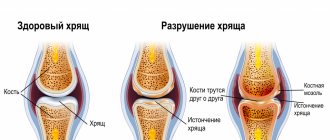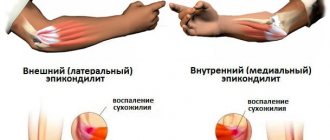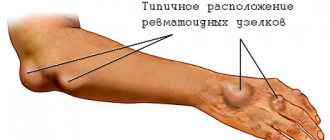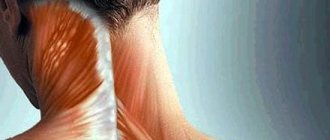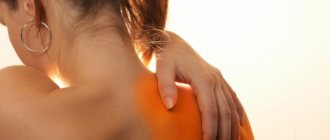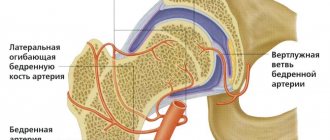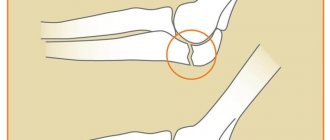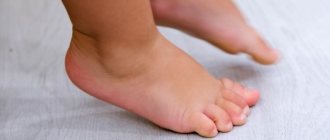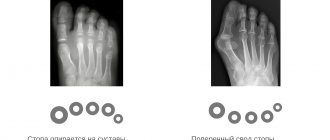Crunching and clicking in the ankle joints usually occurs after 50 years of age due to decreased production of collagen and elastin in the body, poor circulation, and slower regeneration of cartilage tissue. In young people, these sounds rarely appear: usually after sports injuries, intense training, or heavy physical work. The causes of cracking joints while walking are natural and pathological. It is impossible to differentiate them independently at home. After visiting a doctor, a number of instrumental studies are carried out, of which radiography is the most informative. Laboratory diagnostics are indicated when crunching, swelling and pain occur simultaneously.
Crunching in the ankle.
Therapy depends on the established disease, the severity of its symptoms and the stage of its course. If the cause of the crunch in the ankle joint is natural, then the patient is recommended to make adjustments to his usual lifestyle. For example, drink more fluids, avoid serious stress on the joint.
Natural causes
If a crunch in the ankle occurs infrequently and is not accompanied by any discomfort, then in 90% of cases no pathology will be detected during examination. The appearance of sounds, or crepitus, is explained by the accumulation of carbon dioxide bubbles in the articular cavity. When movement begins, the synovial bursa stretches and the pressure in it increases. At this moment, one large bubble is formed, which collapses with a sharp sound. Typically, a cracking sound is heard when the joint is extended, not flexed. Crepitation is typical for people leading a sedentary lifestyle. While they spend time at the computer or watching TV series, many bubbles with carbon dioxide accumulate in the synovial fluid. Therefore, when you start moving or stretching, almost all large joints crack. Crepitus also occurs in people whose diet is dominated by protein foods (meat, milk, beans).
A decrease in the joint space in the left joint is a sign of incipient arthrosis.
The ankle joint crunches after being in an uncomfortable body position for a long time. When flexed or extended, its constituent elements are difficult to move relative to each other. In this case, cracking is accompanied by pain due to the unnatural distribution of loads on the muscles and ligamentous-tendon apparatus. This cause of crepitus is not considered pathological if the discomfort disappears within a few minutes.
10% of the world's inhabitants have hypermobile joints. They have overly elastic ligaments and tendons due to the biosynthesis of special hyperextensible collagen, so some joints can bend in an anatomically unnatural position. When the connective tissue structures of the ankle are stretched, a specific cracking sound is often heard, especially after a long stay in a static position. Hypermobility is a relatively natural cause of crepitus. People with overly elastic ligaments often experience subluxations and dislocations of the ankle, and after 50 years there is a high likelihood of developing osteoarthritis.
The consequences of ankle hypermobility are dislocations, subluxations, joint injuries.
Pathological causes
A crunch in the ankle can be a symptom of almost any inflammatory or dystrophic-degenerative pathology. If it occurs against the background of pain, morning stiffness and swelling of the joint, then the cause of crepitus is the destruction of bone, cartilage or soft tissue. It is not advisable to delay a visit to the doctor, since all diseases of the musculoskeletal system can be treated conservatively only at the initial stage. What else indicates a pathology developing in the ankle:
- clicks are heard with every flexion and extension of the joint, and become a common occurrence when walking;
- There is no full flexion or extension of the ankle, and a subjective feeling of a certain obstacle arises.
Articular pathology is indicated by a hereditary predisposition to its development. If older relatives suffer from ankle arthritis or osteoarthritis, then the likelihood of it developing in other family members over time is quite high. The risk group also includes people with excess weight, endocrine and metabolic diseases (thyrotoxicosis, hypoparathyroidism, diabetes mellitus). Very often, the development of arthrosis is provoked by previous ankle injuries: fractures, dislocations, ruptures of ligaments, muscles, tendons. What diseases is a symptom of joint crunch:
- gouty, rheumatoid, psoriatic, infectious, reactive arthritis, accompanied by acute or chronic inflammatory process;
- tendinitis, tendovaginitis - inflammation of the tendon and (or) its sheath at the site of attachment to the bone;
- deforming arthrosis, provoked by the destruction of hyaline cartilage, accompanied by the formation of bone growths - osteophytes;
The arrow indicates an osteophyte. - synovitis - inflammation of the synovial membrane, spreading to nearby connective tissue structures;
- chondrocalcinosis, which is characterized by the gradual accumulation of calcium salt crystals in the articular cavity;
- bursitis - inflammation of the synovial bursa, which is accompanied by the accumulation of pathological exudate in its cavity.
Acute form of ankle bursitis.
You should be wary if pain and crunching in the ankle joint when walking appear after a respiratory, intestinal or urogenital infection. Pathogenic bacteria or viruses could penetrate from the primary lesions into the ankle cavity and provoke inflammation. In this case, antibiotic therapy is required to destroy infectious agents.
How to help yourself
X-ray of the ankle joint
If the ankle joint sometimes clicks when walking in a child or adult, but there is no discomfort or pain, perhaps this is a variant of the norm; the functions and structure of all the constituent elements of the ankle joint are not impaired.
If this was preceded by an injury, the crunch is accompanied by pain, the mobility of the joint has changed, it is necessary to be examined and find out the cause.
The following methods will help make a diagnosis:
- Clinical examination (collection of anamnesis and analysis of patient complaints).
- Hardware examination (ankle MRI, x-ray, ultrasound).
- Arthroscopy.
An ultrasound examination will give an idea of the condition of soft and connective tissues (muscles, ligaments, tendons) from all projections.
The bone structure is well diagnosed by X-ray, MRI gives a detailed picture of the condition of the joint as a whole. Arthroscopy helps analyze the synovial fluid and examine the inside of the joint.
Crunching in a child's ankle
In most cases, joints in children and adolescents crack for a natural reason. The children's musculoskeletal system is formed unevenly: ligaments and tendons do not have time to form against the background of constant accelerated bone growth. Therefore, the articular elements move relative to each other with sound accompaniment. Crackling noises during movement occur as a result of the collapse of bubbles containing carbon dioxide. The special structure of children's ligaments, which still contain a lot of super-extensible collagen, also leads to crunching.
In adolescents, crackling occurs due to sudden hormonal changes in the body. During puberty, a large amount of biologically active substances enter the systemic bloodstream, accelerating the already rapid growth of bones. In addition, at this age the body needs an increased amount of protein, which leads to the accumulation of carbon dioxide. In adolescents who are actively involved in sports, clicking sounds are heard in the ankle almost every time they squat or lift weights.
Crunching in the ankle in teenagers is a common occurrence when playing sports.
Parents should immediately contact a pediatric podiatrist if their child complains of sharp or dull pain in the feet. A differential diagnosis of ankylosing spondylitis, juvenile or psoriatic arthritis, and gout will be carried out.
The main ways to eliminate pathological crunching
When an inflammatory or degenerative-dystrophic pathology is diagnosed, treatment begins immediately. If the crunch is accompanied by mild pain or no discomfort occurs at all, then the prognosis for a full recovery is favorable. The only exceptions are autoimmune diseases (gout, psoriatic and rheumatoid arthritis), which cannot yet be fully restored. Their therapy uses basic biological drugs, agents for dissolving and removing uric acid crystals from the body. The functional activity of the ankle is increased with medications for local application:
- ointments with non-steroidal anti-inflammatory components (nimesulide, diclofenac, ketoprofen, ibuprofen, indomethacin). Drugs with powerful anti-inflammatory, anti-exudative, analgesic effects stimulate the production of synovial fluid, which serves as a kind of shock absorber for bone surfaces;
- ointments with a warming effect: Finalgon, Capsicam, Viprosal, Apizartron, Nayatox. Used only after relief of inflammation to improve blood circulation in the ankle. The active ingredients of external products eliminate the deficiency of nutrients and biologically active substances, stimulate the regeneration of damaged ligaments.
Therapeutic regimens for any pathology of the musculoskeletal system necessarily include chondroprotectors with chondroitin, glucosamine, hyaluronic acid, and collagen. These are Teraflex, Artra, Dona, Structum, Chondroxide. It is useful to take such drugs to eliminate crunching that occurs for both pathological and natural reasons. Their ingredients accelerate the restoration of damaged tissues and prevent the development or progression of existing diseases.
Treatment of ankle pain
The treatment tactics for ankle pain directly depend on the cause that caused it. If it is pronounced, CELT specialists first of all direct their efforts to reducing pain symptoms. Injuries, in particular ruptured ankle ligaments, require the application of a plaster cast and rehabilitation procedures.
With arthrosis, the doctor’s task is to relieve pain, improve motor functions and eliminate the possibility of the development of inflammatory processes in cartilage tissue. To do this, the patient is prescribed painkillers and anti-inflammatory drugs, as well as medications that improve blood circulation. It is possible to use gels and ointments that reduce joint pain.
If the cause of pain is arthritis, then undergoing physiotherapeutic procedures and using drugs that stop inflammatory processes will be justified.
At the CELT Pain Clinic, they will develop an individual treatment program for you, including massage, reflexology, systematic therapy, which will restore your health and restore the joy of life!
Make an appointment through the application or by calling +7 +7 We work every day:
- Monday—Friday: 8.00—20.00
- Saturday: 8.00–18.00
- Sunday is a day off
The nearest metro and MCC stations to the clinic:
- Highway of Enthusiasts or Perovo
- Partisan
- Enthusiast Highway
Driving directions
How to deal with natural crunching
If no pathologies are identified in a child with a crunching ankle, then no treatment is required. The condition of the joint will normalize over time, and sound phenomena will no longer accompany all movements of a small child or teenager. Pediatricians recommend enriching the diet with fresh vegetables and fruits, which contain a high concentration of substances necessary for the formation of the skeleton. To improve the functioning of all joints, doctors prescribe balanced complexes of vitamins and microelements: Supradin, Alphabet, Complivit, Vitrum, Selmevit, Multitabs. For babies from 12 months, Pikovit is available in the form of a sweet syrup.
It’s a completely different matter if the ankle joint in adults cracks for natural reasons. This causes not so much physical as psychological discomfort, especially when in public places. One of the effective ways to eliminate it is the use of systemic or local drugs, dietary supplements with chondroprotectors. How to be treated without using medications:
- massage. To eliminate crepitus, various massage techniques are used, since they all improve the condition and functioning of the ankle. The greatest therapeutic effectiveness of massage is typical for classic, acupressure, cupping, and Swedish. During and after treatment procedures, blood circulation in the joint cavity accelerates, preventing the accumulation of carbon dioxide;
Ankle massage.
- correction of diet. The more a person weighs, the more often crackling sounds are heard when walking. But even in people with low weight, movements are often accompanied by crunching. Especially for girls and women who follow a diet and exclude foods with carbohydrates and fats from the daily menu. The diet should be balanced, containing all the necessary nutrients;
- drinking regime. When the ankle is “exploited,” harmful salts, tissue breakdown products, and toxins accumulate in its cavity. Slagging of the joint can lead to crepitus due to impaired trophism. Therefore, orthopedists recommend drinking at least 2-2.5 liters of fluid daily. Drinks with a mild diuretic effect help cleanse the joint cavity. These are berry fruit drinks, fruit compotes, vegetable juices, non-carbonated lightly salted mineral waters.
Another good way to get rid of crunching is an active lifestyle. For people over 50 years old, physical therapy doctors recommend yoga, swimming, long walks in the fresh air, physical therapy or gymnastics. You should avoid only those sports that can lead to serious injuries - skiing, hockey, football. There are no such restrictions for young people. Any kind of sport except weight lifting is suitable for them.
Treatment methods
Electrophoresis of the ankle to get rid of crunching in the joints
The choice of treatment method depends on the diagnosis and the degree of damage to the joint. It could be:
- Conservative drug treatment.
- Surgical intervention.
- Physiotherapy.
- Therapeutic exercise and gymnastics.
To stop the inflammatory process and joint destruction, chondroprotectors and anti-inflammatory drugs, as well as vitamin and mineral complexes, can be used. The medications are prescribed by the doctor, taking into account the clinical picture and possible contraindications. It can be:
- "Teraflex" made in Great Britain.
- "Don", made in Italy.
- "Alflutop", which is made in Romania.
- "Formula C" made in Russia.
This is not the entire list of drugs in this class. Their cost on average is 1,500 thousand rubles and more.
Anti-inflammatory drugs:
- Non-selective drugs: Diclofenac, Indomethacin, Ibuprofen, Ketorolac and medications based on them with a different trade name.
- Selective drugs: Nimesil, Movalis, Xefocam, Celecoxib and others.
Some vitamins and microelements are also necessary that have a beneficial effect on tissue regeneration: B vitamins, vitamins A, E, calcium, phosphorus.
In the most advanced cases, when other methods are useless, surgical intervention is prescribed.
Gymnastics and physiotherapy usually complement conservative treatment; these are effective auxiliary methods during the recovery period after surgery.
Patients are recommended to perform simple ankle exercises, which include rotational movements of the foot, flexion and extension of the ankle, exercise on stairs with toes, and walking on heels and toes. All this strengthens the muscles and trains the ligaments.
If the doctor approves, you can supplement the main treatment with compresses, lotions, ointments with alcohol, propolis, onions, and herbal preparations.
Among the folk methods there are also very interesting and useful recommendations, for example, walking barefoot on sand, grass, stones. This can be done by a teenager, a child, and an adult. This simple exercise strengthens the muscles and affects special points on the foot, which stimulate the functioning of systems and organs.
